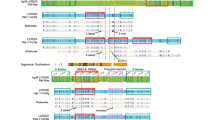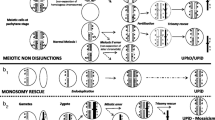Abstract
We have previously examined characteristics of maternal chromosomes 21 that exhibited a single recombination on 21q and proposed that certain recombination configurations are risk factors for either meiosis I (MI) or meiosis II (MII) nondisjunction. The primary goal of this analysis was to examine characteristics of maternal chromosomes 21 that exhibited multiple recombinant events on 21q to determine whether additional risk factors or mechanisms are suggested. In order to identify the origin (maternal or paternal) and stage (MI or MII) of the meiotic errors, as well as placement of recombination, we genotyped over 1,500 SNPs on 21q. Our analyses included 785 maternal MI errors, 87 of which exhibited two recombinations on 21q, and 283 maternal MII errors, 81 of which exhibited two recombinations on 21q. Among MI cases, the average location of the distal recombination was proximal to that of normally segregating chromosomes 21 (35.28 vs. 38.86 Mb), a different pattern than that seen for single events and one that suggests an association with genomic features. For MII errors, the most proximal recombination was closer to the centromere than that on normally segregating chromosomes 21 and this proximity was associated with increasing maternal age. This pattern is same as that seen among MII errors that exhibit only one recombination. These findings are important as they help us better understand mechanisms that may underlie both age-related and nonage-related meiotic chromosome mal-segregation.

Similar content being viewed by others
References
Angell RR (1991) Predivision in human oocytes at meiosis I: a mechanism for trisomy formation in man. Hum Genet 86:383–387
Antonarakis SE (1991) Parental origin of the extra chromosome in trisomy 21 as indicated by analysis of DNA polymorphisms. Down Syndrome Collaborative Group. N Engl J Med 324:872–876
Baudat F, Buard J, Grey C, Fledel-Alon A, Ober C, Przeworski M, Coop G, de Massy B (2010) PRDM9 is a major determinant of meiotic recombination hotspots in humans and mice. Science 327:836–840
Broman KW, Weber JL (2000) Characterization of human crossover interference. Am J Hum Genet 66:1911–1926
Broman KW, Murray JC, Sheffield VC, White RL, Weber JL (1998) Comprehensive human genetic maps: individual and sex-specific variation in recombination. Am J Hum Genet 63:861–869
Chowdhury R, Bois PR, Feingold E, Sherman SL, Cheung VG (2009) Genetic analysis of variation in human meiotic recombination. PLoS Genet 5:e1000648
Dawber TR, Meadors GF, Moore FE Jr (1951) Epidemiological approaches to heart disease: the Framingham Study. Am J Public Health Nations Health 41:279–281
Dernburg AF (2001) Here, there, and everywhere: kinetochore function on holocentric chromosomes. J Cell Biol 153:F33–F38
Freeman SB, Allen EG, Oxford-Wright CL, Tinker SW, Druschel C, Hobbs CA, O’Leary LA, Romitti PA, Royle MH, Torfs CP, Sherman SL (2007) The National Down Syndrome Project: design and implementation. Public Health Rep 122:62–72
Ghosh S, Feingold E, Dey SK (2009) Etiology of Down syndrome: evidence for consistent association among altered meiotic recombination, nondisjunction, and maternal age across populations. Am J Med Genet A 149A:1415–1420
Hassold TJ, Jacobs PA (1984) Trisomy in man. Annu Rev Genet 18:69–97
Hassold T, Sherman S, Hunt PA (1995) The origin of trisomy in humans. Prog Clin Biol Res 393:1–12
Hassold T, Abruzzo M, Adkins K, Griffin D, Merrill M, Millie E, Saker D, Shen J, Zaragoza M (1996) Human aneuploidy: incidence, origin, and etiology. Environ Mol Mutagen 28:167–175
Hawley RS, Frazier JA, Rasooly R (1994) Separation anxiety: the etiology of nondisjunction in flies and people. Hum Mol Genet 3:1521–1528
Koehler KE, Hawley RS, Sherman S, Hassold T (1996) Recombination and nondisjunction in humans and flies. Hum Mol Genet 5 Spec No: 1495–504
Kong A, Barnard J, Gudbjartsson DF, Thorleifsson G, Jonsdottir G, Sigurdardottir S, Richardsson B, Jonsdottir J, Thorgeirsson T, Frigge ML, Lamb NE, Sherman S, Gulcher JR, Stefansson K (2004) Recombination rate and reproductive success in humans. Nat Genet 36:1203–1206
Lamb NE, Freeman SB, Savage-Austin A, Pettay D, Taft L, Hersey J, Gu Y, Shen J, Saker D, May KM, Avramopoulos D, Petersen MB, Hallberg A, Mikkelsen M, Hassold TJ, Sherman SL (1996) Susceptible chiasmate configurations of chromosome 21 predispose to nondisjunction in both maternal meiosis I and meiosis II. Nat Genet 14:400–405
Lamb NE, Feingold E, Savage A, Avramopoulos D, Freeman S, Gu Y, Hallberg A, Hersey J, Karadima G, Pettay D, Saker D, Shen J, Taft L, Mikkelsen M, Petersen MB, Hassold T, Sherman SL (1997) Characterization of susceptible chiasma configurations that increase the risk for maternal nondisjunction of chromosome 21. Hum Mol Genet 6:1391–1399
Munz P (1994) An analysis of interference in the fission yeast Schizosaccharomyces pombe. Genetics 137:701–707
Nicklas RB (1974) Chromosome segregation mechanisms. Genetics 78:205–213
Oliver TR, Feingold E, Yu K, Cheung V, Tinker S, Yadav-Shah M, Masse N, Sherman SL (2008) New insights into human nondisjunction of chromosome 21 in oocytes. PLoS Genet 4:e1000033
Orr-Weaver T (1996) Meiotic nondisjunction does the two-step. Nat Genet 14:374–376
Pan H, Ma P, Zhu W, Schultz RM (2008) Age-associated increase in aneuploidy and changes in gene expression in mouse eggs. Dev Biol 316:397–407
Polk DE, Weyant RJ, Crout RJ, McNeil DW, Tarter RE, Thomas JG, Marazita ML (2008) Study protocol of the Center for Oral Health Research in Appalachia (COHRA) etiology study. BMC Oral Health 8:18
Robinson W, Kuckinka BD, Bernascoi F, Brondum-Neilsen K, Christian S, Horsthemke B, Langlois S, Ledbetter D, Michaelis R, Petersen M, Schinzel A, Schuffenhauer S, Schulze A, Hassold T (1998) Maternal meiosis I nondisjunction of chromosome 15: dependence of the maternal age effect on the level of recombination. Hum Mol Genet 7:1011–1109
Ross LO, Maxfield R, Dawson D (1996) Exchanges are not equally able to enhance meiotic chromosome segregation in yeast. Proc Natl Acad Sci USA 93:4979–4983
Steuerwald N, Cohen J, Herrera RJ, Sandalinas M, Brenner CA (2001) Association between spindle assembly checkpoint expression and maternal age in human oocytes. Mol Hum Reprod 7:49–55
Thomas NS, Ennis S, Sharp AJ, Durkie M, Hassold TJ, Collins AR, Jacobs PA (2001) Maternal sex chromosome non-disjunction: evidence for X chromosome-specific risk factors. Hum Mol Genet 10:243–250
Weiss LA, Shen Y, Korn JM, Arking DE, Miller DT, Fossdal R, Saemundsen E, Stefansson H, Ferreira MA, Green T, Platt OS, Ruderfer DM, Walsh CA, Altshuler D, Chakravarti A, Tanzi RE, Stefansson K, Santangelo SL, Gusella JF, Sklar P, Wu BL, Daly MJ (2008) Association between microdeletion and microduplication at 16p11.2 and autism. N Engl J Med 358:667–675
Zhao H, Speed TP, McPeek MS (1995) Statistical analysis of crossover interference using the Chi-square model. Genetics 139:1045–1056
Acknowledgments
We would like to thank our lab personnel, recruiters and the families that participated in this study. This work was supported by the National Institutes of Health (1T32MH087977, R01 HD057029, R01 HD38979, R01 HL083300, R01-DE 014899 and U01-DE018903); the Center for Inherited Disease Research (HHSN268200782096C); and the Children’s Healthcare of Atlanta Cardiac Research Committee.
Author information
Authors and Affiliations
Corresponding author
Rights and permissions
About this article
Cite this article
Oliver, T.R., Tinker, S.W., Allen, E.G. et al. Altered patterns of multiple recombinant events are associated with nondisjunction of chromosome 21. Hum Genet 131, 1039–1046 (2012). https://doi.org/10.1007/s00439-011-1121-7
Received:
Accepted:
Published:
Issue Date:
DOI: https://doi.org/10.1007/s00439-011-1121-7




